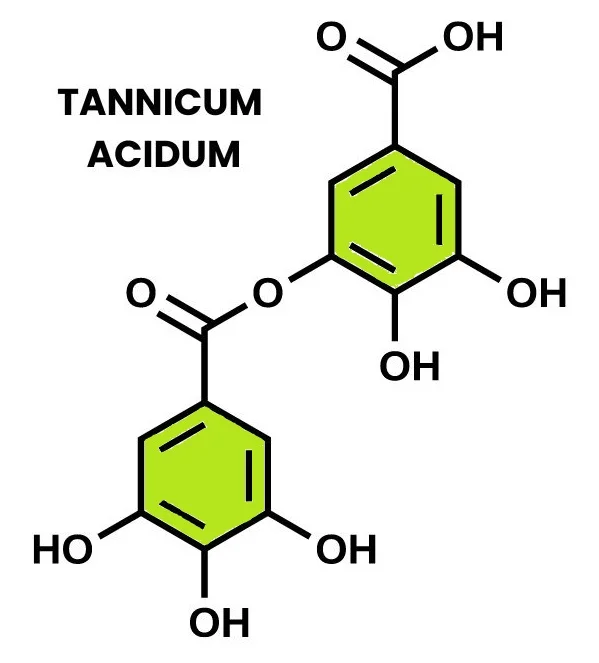Tannic acid, also known as digallic acid, is a polyphenol derived from plant sources and used in both conventional and homeopathic medicine.
Primarily known for its astringent properties, it has a long history of usage for treating excessive secretions from mucous membranes, stopping bleeding, and reducing tissue inflammation.
In homeopathy, it finds its place in treating conditions like nervous coughs, abdominal pain, and constipation.

Table of Contents
ToggleSOURCE INFORMATION
Scientific Classification
- Family: Fagaceae
- Class: Polyphenolic compounds
- Common Name: Tannic Acid, Digallic Acid
Origin and Historical Facts
- Tannic acid is found in various plant sources such as oak, sumac, and chestnut trees.
- Historically, it was widely used in medicine for its astringent properties, especially to stop bleeding and control mucous membrane secretions.
- It was also employed in leather tanning processes, hence the name “tannic.”
- In the 19th century, it was recognized for its ability to contract tissues and arrest hemorrhages.
DRUG PATHOGENESIS
- Tannicum Acidum acts by contracting tissues and reducing secretions from mucous membranes.
- It primarily targets the digestive system and respiratory tract, addressing conditions involving excessive secretions, bleeding, and stubborn abdominal discomfort.
- The remedy also aids in controlling nervous coughs and correcting body odors due to excessive sweating.
KEY CHARACTERISTICS
- Astringent action: Contracts tissues, reducing excessive secretions and bleeding.
- Respiratory relief: Helps in cases of nervous and persistent coughs.
- Digestive aid: Relieves abdominal pain and obstinate constipation by reducing intestinal inflammation.
- Fetor control: Corrects the foul odour of sweat, particularly in cases of osmidrosis.
DETAILED ORGAN SYMPTOMS
- Respiratory System: Known for its effectiveness in treating persistent, nervous coughs. It acts by calming the irritated mucous membranes, helping to suppress excessive coughing.
- Digestive System: Helps with obstinate constipation and abdominal pain. Patients may feel their intestines as if they are swollen or enlarged, and the abdomen becomes sensitive to pressure.
- Urinary System: Used in cases of hematuria (blood in urine), as its astringent properties can help manage bleeding.
- Skin and Sweat Glands: Used to treat osmidrosis, a condition involving excessive and foul-smelling perspiration. Tannic acid corrects the odor by reducing sweat gland activity.
MODALITIES
- Worse: With pressure on the abdomen, excessive physical activity, or heavy coughing.
- Better: Rest, reducing physical activity, and treatment of local areas with astringent solutions.
WHAT ARE MODALITIES IN HOMOEOPATHY?
RELATIONSHIP WITH OTHER DRUGS
- Compare: Gallic acid (for its similar astringent properties and its role in treating hemorrhage).
DOSE
- Typically used in homeopathic solutions as a one-half percent solution. The precise dosage and potency vary according to individual cases and should be determined by a professional.
Frequently Asked Questions
What is Tannicum Acidum used for?
- It is primarily used for its astringent properties to treat excessive mucous membrane secretions, stop bleeding, manage abdominal pain, and control nervous coughs.
Can it help with constipation?
- Yes, it is useful in treating obstinate constipation, especially when the intestines feel swollen or sensitive.
Is it safe to use Tannic Acid locally?
- Yes, in diluted forms (one-half percent solution), it is used for local applications, particularly to stop bleeding and manage excessive sweating or osmidrosis.
Meaning of Difficult Words
- Astringent: A substance that causes tissues to contract or shrink, often used to reduce bleeding or secretions.
- Haematuria: The presence of blood in urine.
- Osmidrosis: A condition characterized by excessive or abnormal body odor, often caused by overactive sweat glands.
- Fetor: An unpleasant odour, often associated with sweat or breath.
